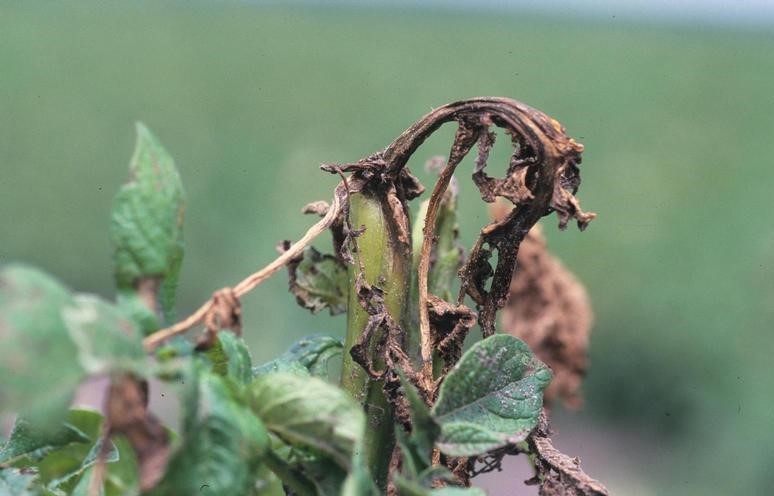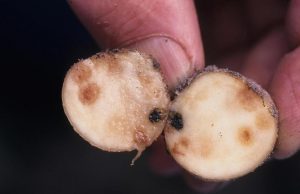Tomato spotted wilt virus: A very sporadic, but destructive potato disease
From 2001-04, a project was undertaken to determine the drivers behind the epidemics of tomato spotted wilt virus that had recently occurred in potato crops in southern Australia, and to investigate varietal susceptibility. Project Lead Professor Calum Wilson spoke to Potatoes Australia in 2019 about this research and its outcomes.
Tomato spotted wilt virus (TSWV) is an aggressive, sporadic disease that has over 1,000 plant host species including many vegetable and ornamental crops.
While major epidemics in potato are rare, when they do occur – as was found during the late 1990s and early 2000s in parts of southern Australia’s potato production regions – significant losses will occur.
Early infection of potato plants by TSWV can greatly suppress plant growth and subsequent yields. Late infections may be difficult to detect, and the virus can move to tubers, affecting tuber quality in commercial crops and leading to rejection of certification for seed crops. TSWV infection in tubers can lead to internal blackening and necrosis.
Often the symptoms may not be obvious from the outside of the tuber, and symptoms of infected produce may be discovered by the purchaser. This was a significant issue in processed potato crops in the early 2000s where culling of symptomatic tubers at the factory resulted in major additional costs.
To understand what was driving these disease epidemics, Professor Calum Wilson and PhD student Charles Jericho from the University of Tasmania, along with Paul Frost and Calluna Denwood from SAFRIES, undertook project PT00019 – Management of tomato spotted wilt virus in potatoes, a strategic levy investment under the Hort Innovation Fresh Potato and Potato Processing Funds.
Project background
TSWV infections in Australian potato crops are not new, with historic epidemics noted in the 1940s and 1950s. Major outbreaks occurred again in the late 1990s, which coincided with the first detection of western flower thrips in Australia.
“There was concern that there was some link between the western flower thrips’ arrival and the subsequent increase in TSWV epidemics in potato. The western flower thrips is generally regarded as the most efficient vector of TSWV globally,” Professor Wilson said.
The project focused on varietal screening to discover if any effective resistance was available in commercial potato varieties, and studies to determine what thrips’ vectors were associated with potato epidemics and where possible sources of the virus resided.
“It was trying to understand why we get these sporadic outbreaks,” Professor Wilson said.
A series of variety screening trials were established, and the efficacy of insecticides for control was examined. Insect sticky traps were placed in commercial crops throughout southern Australia to identify thrips present where TSWV was found.
Crops were regularly monitored to record the initial infection levels, which may have come from infected seed, and subsequent spread of the virus.
Tomato spotted wilt virus symptoms. Images courtesy of Gerald Holmes, California Polytechnic State University at San Luis Obispo, Bugwood.org.
Recorded results
The researchers discovered that onion thrips in Tasmania and both onion and tomato thrips in mainland sites were the only TSWV vectors associated with southern Australian potato crops. Western flower thrips were never found on any traps. Subsequent testing showed that onion and tomato thrips are as efficient at transmitting TSWV as western flower thrips.
“Within potato crops, there was no association between thrips numbers and TSWV infection levels. We had fields where there were large amounts of virus spread with relatively low thrips levels and conversely, we had high thrips levels and no virus spread,” Professor Wilson said.
Surveys of weeds and other possible alternate plant hosts of TSWV around the crops revealed that inoculum sources varied depending on the location.
“In South Australia, around these large pivots that were getting infected, there was a scattering of various weed plants that had the virus, but the suspicion was that the major inoculum sources were coming from much further away; perhaps from an infected crop that was never identified,” Professor Wilson said.
“As the season progressed, when we headed towards mid-summer and other crops were being harvested or other sources were harvested or drying off, a mass flight of thrips would hone in on the only green thing left – which was an irrigated pivot of potatoes, and you’d get a massive infection all in one hit.”
In Tasmania it was a slightly different scenario, as Professor Wilson explained.
“We tended to get more localised infections from the edges of the crop moving in, which suggested that the local weeds and other plants immediately surrounding the crops were actually the source. Understanding the source was important for control, and that very much depended on where you were.”
Professor Wilson said that another result of this project was the raised awareness of TSWV as an issue for the potato industry, which prompted the virus to be considered for seed potato certification.
“For instance, in Western Australia they still routinely screen potato seed for TSWV and certify on that basis. This is trying to reduce the sources of virus within the potato seed.”
Variety testing showed that no potato variety was immune or highly resistant to infection. There were differences in the efficiency of movement of the virus to tubers of infected plants, and in expression of necrosis or blackening in infected tubers.
Preliminary testing of foliar and preplant insecticide treatments suggested they offer limited value for disease control.
Tomato-spotted wilt virus symptoms.
Advice for growers
As TSWV is a very unpredictable disease in potato production, growers are restricted in the ways to limit the impact of the virus.
In periods of absence of the disease there is little for growers to be concerned about, apart from being vigilant in crop scouting. The foliar symptoms of TSWV infection can resemble and be mistaken for early blight infections.
If, however, a new epidemic season does arrive, there remain very few options for management. There are no potato varieties that show effective resistance to TSWV, although some appear to be less prone to tuber infection and blackening.
Thrips may be relatively easy to kill; however, insecticide treatments are generally ineffective as virus spread can occur very rapidly by thrips migrating into the crop and crop treatments are generally too late. Pre-plant insecticides that might help to make the plants less attractive may also interfere with Integrated Pest Management strategies.
Management of virus sources may be problematic as well, as evidence suggested these may be at some distance from the crop, beyond the control of the grower. If epidemics resurge, emphasis on trying to find the distant inoculum sources will be critical to predict the likelihood of disease.
It is important to note that infections in seed crops can result in virus transmission to tubers which lead to epidemics in subsequent crops, therefore planting of certified seed is always important for virus control.
Find out more
For more information, please contact Professor Calum Wilson at calum.wilson@utas.edu.au.
The final report for this project is available on InfoVeg.
This project has been funded by Hort Innovation using the fresh potato and potato processing research and development levies and contributions from the Australian Government.
Project Number: PT00019



